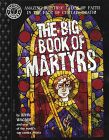

| The Big Book of Martyrs. By John Wagner and "51 of the World's Top Comic Artists!" New York: Paradox Press, 1997.191p. index. (A Factoid Book). $14.95pa. ISBN 1-56389-360-6. |

|
GENRES: AUDIENCE: SYNOPSIS: Each short treatment of a martyr (they average about three-four pages each) contains that person's basic story, what that individual is patron saint of (if anything), and Feast Days, if any. Some of the individuals covered are considered partially or entirely fictitious, such as St. Christopher, and are not officially recognized by the Catholic church, but they are still called upon in times of need by the faithful. Also included are a drawn introduction that defines what a martyr is in this context, and an end piece about "Tomorrow's Martyrs," which covers potential new martyrs as well as the concerns that it's too easy for new saints to be canonized. Several of the stories offer more than just a biography of the martyr. For example, "Edith Stein: A Case for Canonization" tells the story of the struggle between Catholics, who wanted to canonize her but couldn't prove that she died for her faith rather than her background, and Jews, who insisted that she died "solely for her Jewishness" and didn't want her used by the Church to preach conversion. Other hitches were that no miracles could be attributed to her, and she had made an awkward statement about making her life "an atonement of the unbelief of the Jewish people." Ultimately, the situation was resolved to everyone's satisfaction by declaring her a martyr and beatifying her but not making her a saint. "Philomena: The Phantom Martyr" details the brief martyrdom of a teenage girl whose remains had been found in 1802 in the catacomb of Priscilla in Rome. The presence of a vial of blood seemed to indicate that this girl had been martyred, and her remains were transferred to a church. Miracles apparently ensued. However, about a hundred years later, scientists determined that the remains were too young to have been from the original burial, and in 1960 the Holy See officially suppressed her cult and ordered her shrine dismantled and feast discontinued, though the dismantling was halted on the order of Pope Paul VI, and pilgrims continue to visit the shrine. EVALUATION: Overall the black-and-white art is better than that in The Big Book of Urban Legends and more varied in appearance, which is all to the good. Wagner's text is straightforward and objective for the most part, though occasional inanity creeps in; for example, in the "Tomorrow's Martyrs" section, to end the book, he makes the fatuous statement, "Who knows who the martyrs and saints of the future will be? Maybe you?" Ewww.... where the heck was the editor on that last line? The descriptions of both the saints and their tormentors are one-dimensional. Saints are perfect, pious, assured, and fearless (Wagner assures us that they were "people like any of us," but little evidence is given to back this statement up); tormentors are evil, ranting, baffled, and cowardly. I assume the saints couldn't have been done any other way without moving into the realm of the blasphemous. However, one could wish for more insight into the tormentors. For example, "St. Thomas More and St. John Fisher: The Arrogance of Kings" deals with Henry VIII and his establishment of the Church of England after the Catholic Church would not allow him to divorce Catherine of Aragon. Henry VIII is a major historical figure, and to reduce him to the statement "Henry was an arrogant, avaricious man used to getting his own way" is to trivialize the political decisions behind Henry's break with the Church and, indeed, the man's complex personality. Really, that's what this book lacks: an understanding of the fear and politics that prompted such heavy-duty persecutions of the Christians. Although the martyrs' biographies did not need to contain this kind of information, the text sections could well have provided useful background. One wonders exactly what Wagner's qualifications to write such a book were. But I don't know why I'm demanding any kind of scholarliness from this book. (Too much American Reference Books Annual in my background, I guess.) It's exactly what the other books in the series are: a set of short, competent, superficial descriptions of its topic, with minimal thinking required, and it's not fair of me to expect more than that. I suppose that the subject, which is more inherently scholarly than the other subjects treated by this series, seems to demand a more intellectual approach. Regardless, as it stands, Martyrs will have an audience that will find a comics treatment of the subject more appealing than a dry textual one. As a reference book it would be useful for people who want quick, casual descriptions of the Christian martyrs. And it would be a good title for libraries in conservative areas! |
Return to Rational Magic Home
